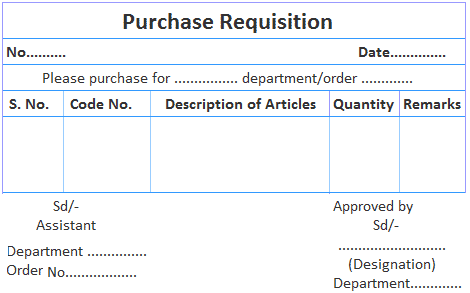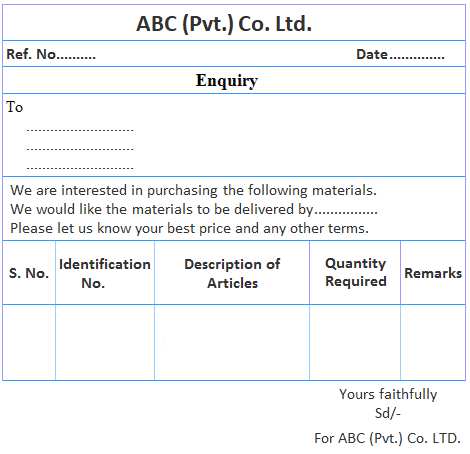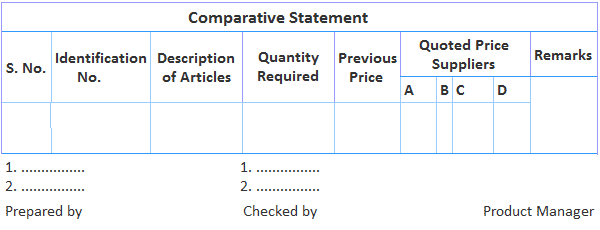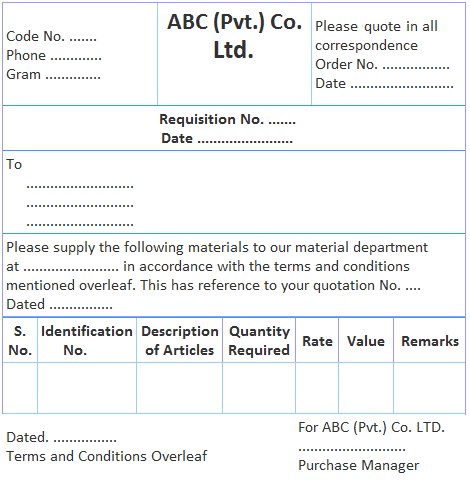Purchasing of materials refers to the procurement of materials for a price. It is usually handled by a specific department (e.g., purchase manager in the procurement department), particularly in large companies. A purchasing department can function effectively if: Purchasing is a critically important and specialized activity in manufacturing companies. Materials account for a considerable portion of production costs. As such, the purchase manager in such a business is responsible for spending more of its money than anyone else. Any errors on the part of the purchase manager, therefore, may be extremely expensive. Furthermore, purchasing sub-standard materials will undermine product quality, cause wastage, and lead to costly machine breakdowns. Hence, it is fundamentally important to ensure that the function of purchasing materials is performed effectively, efficiently, and economically. According to Alford and Beatty, "purchasing is the procuring of materials, supplies, machines, tools, and services required for the equipment, maintenance, and operation of a manufacturing plant." As noted above, the purchasing function is typically performed by a separate purchasing department set up under an expert buyer (or purchase manager). To carry out their duties effectively, the purchase manager must know: Normally, some of the spare parts and components that a manufacturing concern requires are manufactured in the company itself rather than being purchased externally. The various items of stores that the purchasing department should procure are: Decision-making in respect of the items falling under the second category is an important function of the purchasing department. The decision about whether to buy or produce a particular item depends on factors such as: The decision to give preference to buying is of the utmost importance. Such decisions are made by the purchasing department under the guidance of the planning department and cost department. Materials are generally purchased as and when requisitions are received from the stores department. If certain items are only available during a particular season, purchases are made during the season. For items restricted by government regulations, the question of when to purchase will be determined with reference to the date of the license, quota, or permit, as the case may be. The purchasing department generally maintains a list of approved suppliers for various items of materials. Whenever materials are required, purchases are made from these suppliers after receiving their quotes. If there are long-term requirements to purchase materials on a regular basis in bulk, the materials are purchased from specific suppliers only. In the case of controlled materials, purchases are also only made from specific suppliers. The quantity of materials to be purchased is another important criterion for decision-making. The purchase department is guided in this respect by the purchase requisition received from the stores department. However, in organizations that use the budgetary control technique, the purchase budget that is prepared and approved in advance shows the timings and quantity of purchases. Thus, in such cases, the approved budget is the guiding factor. Some manufacturing concerns adopt the control technique of economic order quantity (EOQ), which indicates the quantity and frequency of purchases. EOQ ensures that the costs involved in purchasing materials and carrying inventory are minimized. The price to be paid is a key factor that influences the cost of materials. In case tenders or quotations have been invited and received, it is the responsibility of the purchasing department to select the price at which the materials should be purchased. Normally, in this case, the tender or quotation that offers the lowest price is selected. However, the terms of delivery, credit period allowed, rate of discount, and the reliability and capacity of the supplier to execute orders should also be considered. If materials are supplied through a controlling authority, the purchase manager has no option but to procure the supply at the price fixed by the authority. Purchasing of materials can be undertaken on a centralized or decentralized basis. In either case, it is important to keep in view the nature, size, and requirements of the business. Under centralized purchasing, the authority to purchase materials for all the departments in an organization is placed on one individual or one department (e.g., the purchasing department headed by a purchase manager). The main advantages of centralized purchasing are as follows: Centralized purchasing also has several well-defined limitations, including: Under decentralized purchasing (also known as localized purchasing), the authority to purchase materials is placed in the hands of more than one individual or department. Under this system, each departmental head makes purchases for their own department. Decentralized purchasing is beneficial for the following reasons: Decentralized purchasing also suffers from the following disadvantages: This starts with the receipt of a purchase requisition by the purchasing department. The purchase requisition is prepared by the storekeeper based on: The requisitions are usually approved by staff who are authorized to grant approval. The storekeeper ensures that they are acting according to standard policies. They prepare the purchase requisitions in triplicate. The first one (i.e., the original) is sent to the purchasing department, the next one is sent to the cost department, and the last one is retained by the stores department. More copies may be prepared depending on the requirements of the enterprise. The purchase requisition forms the basis of the order to be placed with suppliers. Therefore, this should be prepared with careful attention. This helps to purchase the right quantity of materials at the right quality, the right place, from the right source, and at the right time. This helps the enterprise to procure materials at a competitive price. It also helps to ensure the smooth and uninterrupted operations of the enterprise. After the receipt of the purchase requisition, the purchase department would proceed further and invite quotations, etc. from suppliers. The usual practice is to send an inquiry proforma to the supplier. The specimen of the Enquiry Proforma is given below : The supplier, after receiving the inquiry letter, provides a quote and states the terms and conditions of the supply of materials to the purchasing department. The supplier also provides quality, quantity, time of delivery, price, discount, and other necessary information. This submission is important from the point of view of both the purchaser and the supplier. It is an offer in legal terms. This, therefore, requires careful handling and proper preservation. The comparative statement (or a comparative schedule of quotations) is prepared after the quotes are received from the supplier. It is prepared with a view to comparing the prices, terms, and conditions, and it helps in selecting the supplier whose terms are most favorable to the organization. The comparative statement is an important document that should be carefully kept on record for future reference and guidance. The prepared statement is submitted to the head of the purchasing department for approval. The purpose of preparing a comparative statement is to realize the money's worth. A proforma of a comparative statement is given below. The last action involved in purchasing materials is to prepare and place a purchase order. A purchase order is a legal document that implies the acceptance of the supplier's offer. The purchase order should, therefore, be prepared with great care and in complete detail. This helps the supplier to ensure that they will supply materials of the right quality, the right quantity, and at the right time. Purchase orders are orders to the supplier to supply the required materials as per their quotations and the instructions contained therein. A proforma of the purchase order is given as follows: Generally, the purchase order is prepared in triplicate. The original copy is dispatched to the supplier, the duplicate is sent to the account section, and the triplicate is retained for future reference. However, if more copies are required, these should also be prepared. For example, if five copies are to be prepared, the fourth one could be sent to storekeeping and the fifth one could be sent to the requisitioning department.What Is Meant by the Purchasing of Materials?
What to Purchase
When to Purchase
Where to Purchase
How Much to Purchase
At What Price to Purchase
Types of Purchasing
Centralized Purchasing
Advantages of Centralized Purchasing
Disadvantages of Centralized Purchasing
Decentralized Purchasing
Advantages of Decentralized Purchasing
Disadvantages of Decentralized Purchasing
Purchasing Procedure or Purchasing Cycle
1. Initiation of Purchase
Format/Specimen of Purchase Requisition

2. Inviting Quotations

3. Receipt of Supplier's Quotation
4. Preparation of Comparative Statement

5. Preparation and Placement of Purchase Order

Purchasing of Materials FAQs
Purchasing of materials refers to the act or process of obtaining goods, services, etc. (Especially the procurement of materials for an organization)
A purchasing department functions effectively if: - it is organized on a centralized basis - full co-operation between purchasing department and other departments is assured - a close relationship exists between the purchasing department and the accounts department - the purchase manager is technically qualified and sufficiently experienced - a proper procedure is clearly set out and strictly adhered to
Purchasing is a critically important and specialized activity in manufacturing companies. Materials account for a considerable portion of production costs. As such, the purchase manager in such a business is responsible for spending more of its money than anyone else. To carry out their duties effectively, the purchase manager must know: - what to purchase - when to purchase - where to purchase - how much to purchase - at what price to purchase
Purchasing of materials can be undertaken on a centralized or decentralized basis.
Decentralized purchasing means an organization has many locations and each location procures its own materials. Centralized purchasing means the procurement of goods is done at a central procurement center for all locations of the organization.
True Tamplin is a published author, public speaker, CEO of UpDigital, and founder of Finance Strategists.
True is a Certified Educator in Personal Finance (CEPF®), author of The Handy Financial Ratios Guide, a member of the Society for Advancing Business Editing and Writing, contributes to his financial education site, Finance Strategists, and has spoken to various financial communities such as the CFA Institute, as well as university students like his Alma mater, Biola University, where he received a bachelor of science in business and data analytics.
To learn more about True, visit his personal website or view his author profiles on Amazon, Nasdaq and Forbes.













